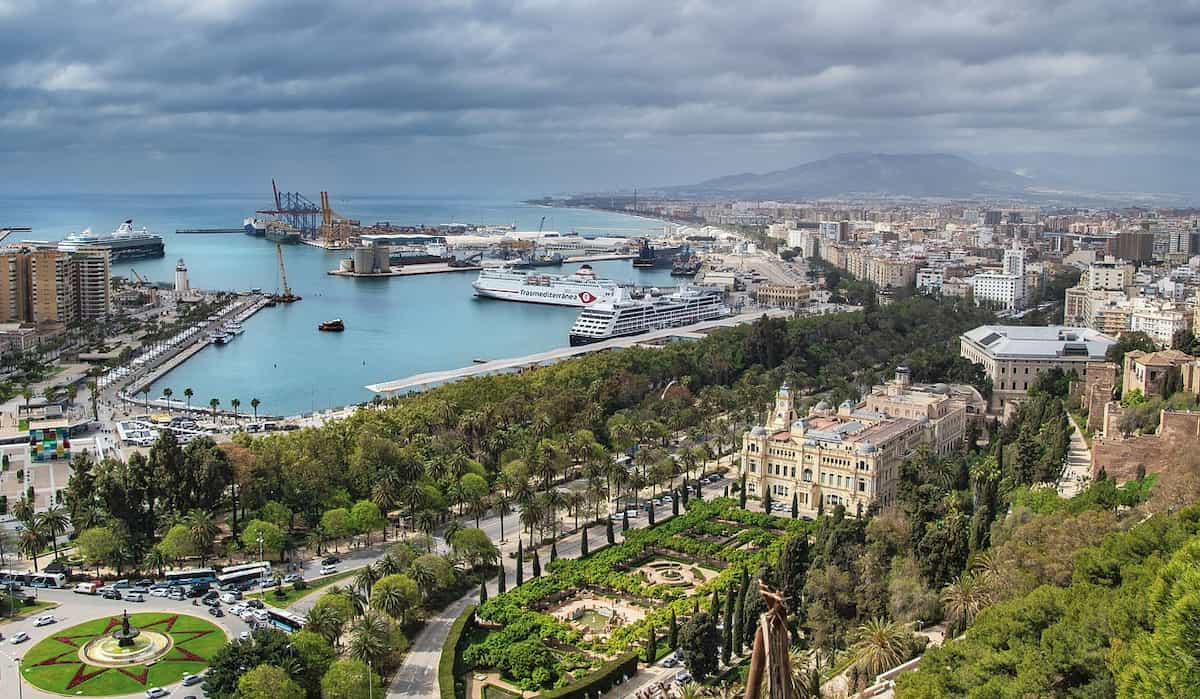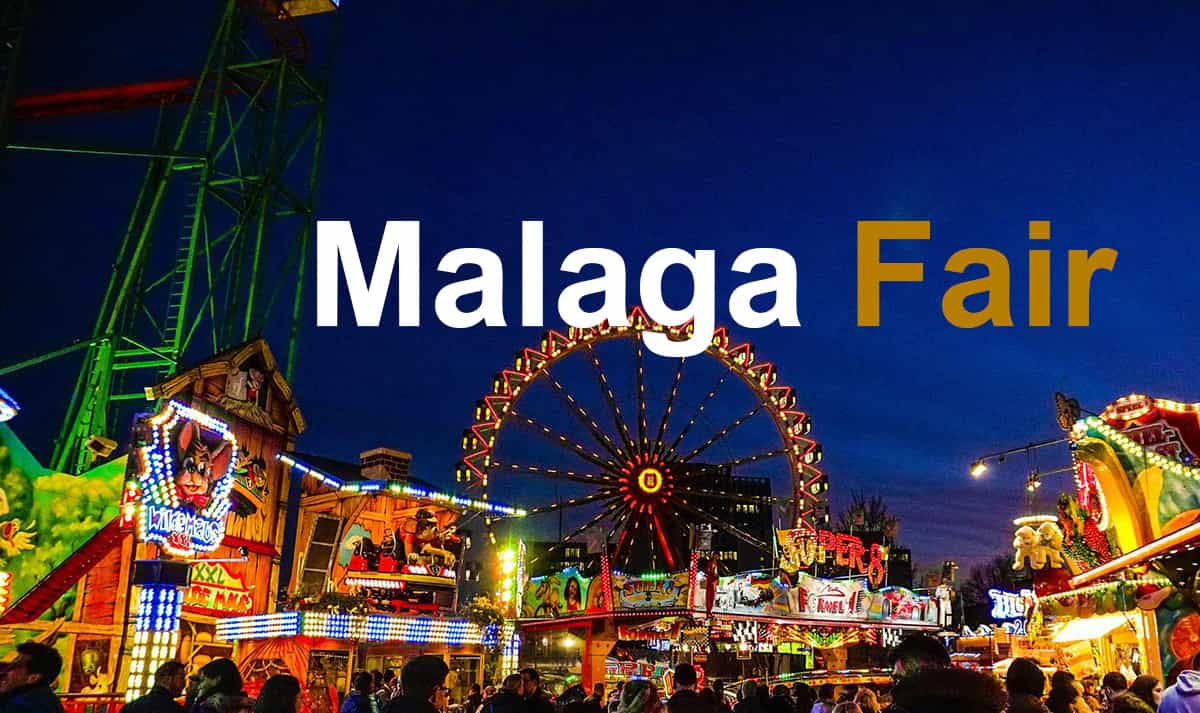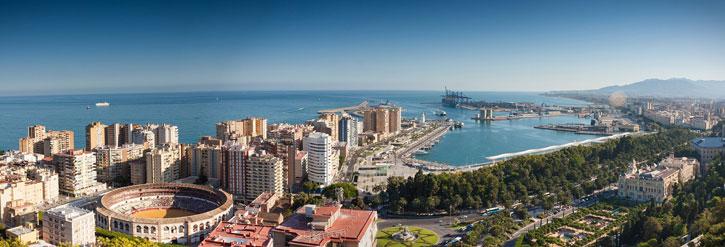Malaga, known as “Malaga the Beautiful,” is the capital of the Costa del Sol and a major Mediterranean port. It stands at the center of a basin between mountains, the River Guadalhorce, and the coastal strip leading to the Axarquia region. Throughout history, Malaga’s location has attracted travelers, merchants, settlers, and warriors.
In the east is the suburb of El Palo, with its typical fishermen’s houses, coves, promenades, and “pescaíto” (small fried fish). Here you’ll find beaches, La Malagueta district, the lighthouse (the symbol of the city), and the port breakwater with a beautiful panoramic view of the city.
In the center, a walk through the Park takes us to Malaga’s old center: the imposing Cathedral; La Alcazaba fortress; Gibralfaro Castle; and Roman Theatre. Further up is Plaza de la Merced square, site of Picasso’s birthplace. Malaga is also home to interesting churches such as St. John’s and St. James’; St. Augustine’s Convent and Episcopal Palace; and civil buildings such as Count of Buenavista’s Palace and Consulate House.
Malaga is a complete city with tourist facilities, golf courses, water sports, and other attractions such as its sunlight, climate, cuisine, and wit of its people. Keep reading to discover more about this beautiful city and all it has to offer.
MALAGA INFORMATION
History
During the 19th century, Malaga was a thriving winter resort for wealthy Europeans. The city has a rich and colourful history spanning about 2,800 years, making it one of the oldest continuously inhabited cities in Western Europe. Its Phoenician and Roman ancestors left their mark all over the centre: the Roman amphitheatre has just been restored to its former glory and Malaga’s Moorish past can be clearly seen in the Alcazaba fortress and Gibralfaro castle.
Pablo Picasso was born here and in 2003 a magnificent museum housing a selection of his works was opened. In conjunction with the new museum, the old quarters of the city are currently being restored and many parts pedestrianised.
At long last, Malaga is making a concerted effort to appeal to the millions of tourists visiting the area. New buildings include the emblematic conference and Exhibition Palace and the Palace of Justice which is currently under construction in Teatinos.
Malaga remains largely untouched by mass tourism and is a genuine Andalusia city. It has been inhabited since prehistoric times, with evidence of settlements dating back to the Bronze Age. The Phoenicians were the first civilization to establish a settlement in Malaga, around 770 BC. They established a trading post and called the city ‘Malaka’.
Over time, Malaga has been ruled by various civilizations, each leaving its mark on the city. The Moors greatly influenced it, introducing new architectural styles such as the famous Alcazaba Fortress and Gibralfaro Castle. The city also became an important cultural centre, with scholars and poets flocking to Malaga.
Today, Malaga is a bustling city with a rich history and vibrant culture. Its historic centre is a popular tourist destination, with attractions such as the Alcazaba, Gibralfaro Castle, and Picasso Museum drawing visitors from around the world.
Sights
Malaga is a city full of history, culture, and beauty. There are many points of interest to visit, but these are just some of the highlights. Walking through the old streets of Malaga is an experience in itself, with its historic buildings, lively atmosphere, and delicious food.
Let’s find some of the sights and places to visit, but remember that below are just some of the many you will find. Feel free to check the Malaga map and explore the surroundings.

Historical Landmarks
- Alcazaba of Malaga: This 11th-century Muslim fortress contains within its walls, walled enclosures, towers, courtyards, reservoirs, and passages. (Map)
- Roman Theatre: Recently restored, this ancient theatre gives us an idea of the importance Malaga had during the Roman domination. (Map)
- Gibralfaro Castle: This Arabic fort offers marvellous views over the city and sea. There is an interesting Interpretation Centre in the interior, overlooking the city of Malaga. (Map)
Museums

- Picasso Musseum: This magnificent museum houses a selection of works by Pablo Picasso, who was born in Malaga in October 1881. (Map)
- Glass and Crystal Museum: This museum houses a collection of over 3,000 pieces of glass from different time periods. (Map)
- Carmen Thyssen: This museum houses a collection of 19th-century Andalusian paintings. (Map)
- Malaga Museum: This museum houses a collection of fine arts and archaeology. (Map)
- CAC Malaga: This contemporary art museum houses works by cutting-edge artists. (Map)
- Pompidou Centre: The Pompidou Museum in Malaga is a branch of the National Centre of Art and Culture Georges Pompidou of France, located in a space called “El Cubo” in the Spanish city of Malaga. It is the first branch of the Centre Pompidou Paris outside of France. (Map)
Gardens

- La Concepcion Botanical Garden: Malaga has five botanic gardens, one of which is “El de la Concepción”, considered to be the second on importance in Europe. (Map)
- Alameda Park: This park is located in the center of Malaga and was built during the late nineteenth century. It is full of art and nature. (Map)
Religious Buildings
- Malaga Cathedral: From the Sixteenth Century, this is one of the most important Renaissance temples in Spain. The interior amazes due to its notable chapels, choir stalls and paintings. (Map)
- Parish Church of El Sagrario: Adjacent to the Cathedral, this church has a splendid gothic-Isabelline façade. (Map)
Other Attractions
- Larios Street: Take a walk without haste around Málaga and cross “El Pasaje de Chinitas”, gardens and squares. Larios Street is the most important and well-known street in the entire city. Its official name is Calle Marqués de Larios. (Map)
- Espetos at the Beach: Enjoy some “espetos” (skewered sardines) at Pedregalejo beach.
- Soho District: Explore this trendy neighbourhood with its street art and hipster vibe. (Map)
- Pier 1: Muelle 1 is a new concept shopping area located in the Port of Malaga. It’s an open space that offers a unique shopping, leisure and dining experience. From here you can also take catamaran excursions throughout the year. (Map)
Festivities

Malaga is a city with a rich history and culture, and it has many festivals and celebrations throughout the year. One of the most famous is the Feria de Agosto, which is held in honor of the entry of the Catholic Monarchs into the city on August 19th. The Feria de Agosto is a vibrant and colorful celebration that takes place in the center of Málaga and in the fairgrounds of Cortijo de Torres. The atmosphere during the fair is warm and welcoming, with the smell of biznagas and the taste of fino and pescaíto frito. During the fair, the city dresses up and is filled with music, dance, food, and drink.
Another important festival in Malaga is Christmas. During this time of year, the city lights up with Christmas lights and is filled with Christmas markets, such as those found in Muelle Uno and Plaza de la Marina. The Christmas atmosphere floods the streets of the capital of the Costa del Sol with activities, events, shopping, and the best atmosphere you can imagine. In Alameda Park you can also find Christmas attractions.
In addition to these festivities, Malaga also celebrates others such as Halloween, with events such as Internado del Terror at the Botanical Garden, or Fiesta Mayor de Verdiales, on December 28th. There is also Holy Week, which is deeply lived and particular in Malaga.

Fiesta Mayor de Verdiales
The Fiesta Mayor de Verdiales takes place on December 28th every year at the fairgrounds of Puerto de la Torre. This brings together pandas from all corners of the province of Malaga to experience a day where singing and dancing are the protagonists. The Fiesta Mayor de Verdiales has been celebrated for more than 50 years in an organized manner to promote the recovery and dissemination of this important cultural heritage of the province of Malaga. The party was conceived as a contest that pits different participants by styles: Montes, Almogía, and Comares.
Holy Week
Holy Week in Malaga is a great event of religious, social, and cultural character that takes place every year in the city of Malaga. Processional parades take place from Palm Sunday to Good Friday, leaving Holy Saturday as a lapse until Easter Sunday. During Lent and until Passion Saturday 5 Brotherhoods process, as well as numerous associations and parish groups. The floats on which the sacred images are carried in Malaga are called tronos (thrones), and unlike other Holy Weeks in Spanish geography, they are very large in size and of great cultural interest.
Gastronomy
Malaga is a city with a rich history and culture, and it has many festivals and celebrations throughout the year. During these festivals, there are often special traditional foods that are consumed exclusively during these dates. For example, during the August Fair, it is common to enjoy dishes such as paella, sardines, and fried fish. During Holy Week, traditional sweets such as torrijas and pestiños are popular.
Here is some more information about the food and festivals in Malaga:
- Malaga is known for its delicious cuisine, which includes traditional dishes such as gazpachuelo, a warm soup made with fish stock, mayonnaise, and egg yolk. Another popular dish is the Plato de los Montes, a hearty combination of pork loin, chorizo, black pudding, potatoes, peppers, and a fried egg.
- Malaga is also famous for its sweet wines made from Moscatel and Pedro Ximenez grapes. The province has three Denominaciones de Origen (DOs): DO Malaga (mostly sweet white wines), DO Sierra de Malaga (white, rose and red wines), and DO Pasas de Malaga (raisins).
- The city has several food markets where you can find fresh produce and local specialties. Some of the best food markets in Malaga include the Mercado de Atarazanas, Mercado de Salamanca (El Molinillo), Mercado de El Carmen, Mercado de Bailén, and Mercado de la Merced.
Services
Malaga is a city that offers a wide range of services and facilities for tourists. For sports enthusiasts, the city boasts excellent facilities such as the Martín Carpena stadium, home to the city’s top basketball team, and the Rosaleda football stadium, home to Malaga Club de Fútbol. The stadium has a seating capacity of 30,044 seats.
If shopping is more your thing, Malaga has plenty to offer. The city center, particularly around the pedestrianized Calle Larios, has a wide range of shops and boutiques. There are also many shopping centers around the periphery of the city, where you can find large stores and hypermarkets. Prices for many items in Malaga are often cheaper than on the coast, so it’s a great place to grab a bargain.
Communications

Malaga has an extensive network of bus services run by EMT, which connects most parts of the city with the center. There are around 40 routes running from approximately 6:30 am to midnight, seven days a week, although there are fewer services on Sundays and public holidays. The bus service is currently undergoing extensive modernization, including the fitting of all buses with GPS navigation systems. For further information about buses in Malaga, you can call 902-527-200 or visit the EMT website.
The main train station, María Zambrano, has services to Cordoba, Granada, Madrid, and Seville. The station has a waiting room, café and bar, and several small shops. It is also surrounded by a large shopping center. The station was rebuilt in preparation for the new high-speed train line that was completed in 2007. The current underground station for local trains is part of the new Malaga underground system.
The metro currently has two lines: Line 1 runs from Andalucía Tech to Atarazanas every 6 minutes, and Line 2 runs from Palacio de los Deportes to Hospital Civil. There are a total of 17 stations. Further information is available from the Malaga metro website.
If you prefer to have more flexibility and freedom when exploring Malaga and its surroundings, Malaga car hire is a great option. With a car, you can easily visit any place in the province by road and even discover Andalusia from Malaga by car. There are many beautiful towns and villages to explore in the region, as well as stunning natural parks and beaches.
Areas in Malaga
Malaga Centre
The center of Malaga is a bustling and vibrant area, full of historic buildings, museums, and monuments. It is also home to many shops, restaurants, and bars, making it a great place to explore on foot. Some of the top attractions in the center of Malaga include the Alcazaba, the Roman Theatre, and the Cathedral.
Malaga East
The eastern part of Malaga is a more peaceful and relaxed area, with plenty of green spaces and parks. It is also home to some of the city’s most beautiful beaches, such as Playa del Palo and Playa de Pedregalejo. One of Malaga’s fastest-growing areas is Teatinos, which is near the university.
Malaga West
The western part of Malaga is a fast-expanding area that includes the Nuevo Paseo Marítimo, where many luxury apartment blocks are under construction. This area is also home to several large shopping centers and sports facilities.
